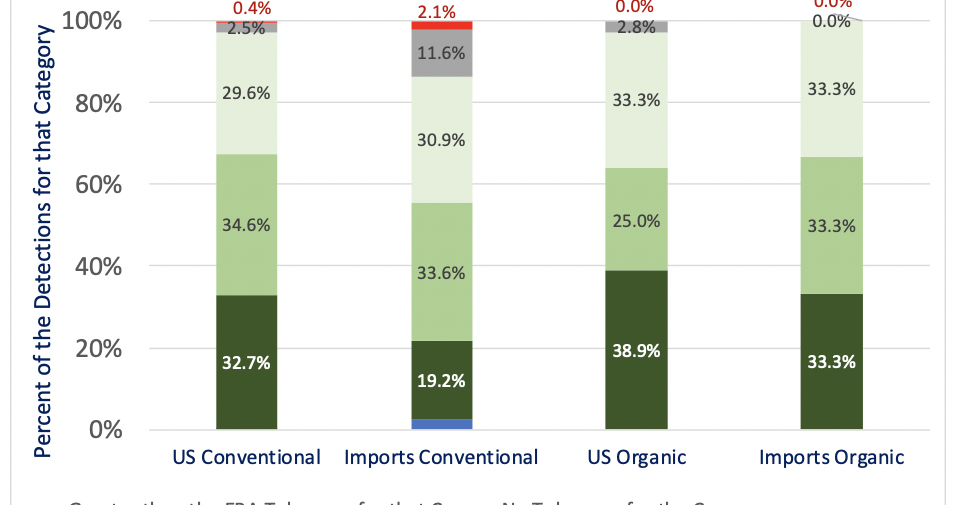
ScreenShot2019 10 30at4.07.05PM.png
California Food Safety Check
They recently released
their results for 2018. They tested
a total of 3,666 samples of 140 different crops grown in California, other
US states and items that were imported from 25 different countries. For each sample they analyzed for 400 different
pesticides or their known breakdown products. This is also part of an enforcement program so it is great that they are still so transparent with their findings.
to insure that by the time it gets to consumers is quite safe. That safety standard is based on national standards set by the EPA. For 78% of the crops there we either no
detectable residues or residues below the legal limits. Few of the remaining examples were at all problematic
Particularly for the US grown samples, excessive
concentrations were very rare. There were
some residues of chemicals found which are not technically supposed to be used on that crop,
and as in the past most of these “no established tolerance” cases were on the imported
items.
no detected residues should exceed 5% of the EPA tolerance . In 2018 only 55.4% of detections from organic sample met that standard so they should not have been able to be sold as “USDA Organic Certified.”
Imported organic residues over 5% of the tolerance made up 66.7% of detections which is very similar to that
same measure for domestic conventional produce.
55.4% of the detections on imported conventional crops would not have disqualified them if someone was trying to sell them as organic. Below is the list of specific pesticide residues that were found on organic samples.
| AMETOCTRADIN 1, BIFENAZATE 1, BIFENTHRIN 1, CAPTAN 1, CHLORPROPHAM 2, CYAZOFAMID 1, CYPERMETHRIN 1, CYPRODINIL 1, CYROMAZINE 1, DDE 5, DIELDRIN 1, FENAMIDONE 1, FLONICAMID 2, FLUBENDIAMIDE 1, FLUDIOXONIL 4, FLUOPICOLIDE 1, FLUOPYRAM 3, FLUPYRADIFURONE 1, IMIDACLOPRID 2, MANDIPROPAMID 1, PENDIMETHALIN 1, PENTHIOPYRAD 1, PERMETHRIN 2, PROPAMOCARB 1, PYRACLOSTROBIN 1, PYRIMETHANIL 1, ROTENONE 2, SPINOSAD 16 |
Those who think they are buying something safer by spending more for organic might want to rethink that logic. Only the 16 spinosad detections represent something allowed for use on organic, and organic still has the legacy of residual DDT metabolites like DDE.
Lychee (China), Cactus Pear (Mexico), Star Apple (Vietnam)m and Tomatillo (Mexico). They also added Star Apple from Vietnam and Guaje from Mexico because of products
found there for which there is no set tolerance.
also incredibly diverse. This testing program is different from the USDA’s
Pesticide Data Program (PDP) in that it includes a number of more exotic
items. However it also includes many more mainstream fruits and vegetables and among those there were no above-tolerance detections. But in both cases the take-away
is that we should enjoy our fruit and vegetable options and consume them as part
of a healthy lifestyle.
Source link
2019-10-31 12:00:00
Karl Hoffman is a distinguished agriculturalist with over four decades of experience in sustainable farming practices. He holds a Ph.D. in Agronomy from Cornell University and has made significant contributions as a professor at Iowa State University. Hoffman’s groundbreaking research on integrated pest management and soil health has revolutionized modern agriculture. As a respected farm journalist, his column “Field Notes with Karl Hoffman” and his blog “The Modern Farmer” provide insightful, practical advice to a global audience. Hoffman’s work with the USDA and the United Nations FAO has enhanced food security worldwide. His awards include the USDA’s Distinguished Service Award and the World Food Prize, reflecting his profound impact on agriculture and sustainability.









